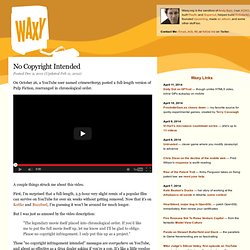

No copyright infringement intended. No Copyright Intended. On October 26, a YouTube user named crimewriter95 posted a full-length version of Pulp Fiction, rearranged in chronological order.

A couple things struck me about this video. First, I'm surprised that a full-length, 2.5-hour very slight remix of a popular film can survive on YouTube for over six weeks without getting removed. Now that it's on Kottke and Buzzfeed, I'm guessing it won't be around for much longer. But I was just as amused by the video description: "The legendary movie itself placed into chronological order. These "no copyright infringement intended" messages are everywhere on YouTube, and about as effective as a drug dealer asking if you're a cop. How pervasive is it? Judging by his username, I'm guessing crimewriter95 is 16 years old. He's hardly alone. YouTube's tried to combat these misconceptions with its Copyright School, but it seems futile.
Under current copyright law, nearly every cover song on YouTube is technically illegal. 3. Copyright Myths. When I first started dealing with copyright issues about eight years ago I, like most people, was bombarded with a great deal of copyright myths and urban legends.

Though I knew that most were false, I have to admit to having believed a few for at least for a while. But now that I am a older and hopefully a little bit wiser in this area, I tear through the worst of the myths pretty easily. However, still see them being thrown around, day after day, by well-meaning people on the Web. So I wanted to take a few moments to address some of my “favorite” copyright myths, explain why they are false and perhaps offer some lesser-known copyright truths. If It Doesn’t Have the © Then it Isn’t Copyrighted There was a time that this myth was true. I still encourage people to put formal copyright notices on their sites. It may not have any legal standing, but it can definitely save some headaches.
In short, it’s a good idea to include a copyright notice, but it isn’t necessary. I Copyrighted That Name. 3D Printing And Intellectual Property Rights Issues. This article was submitted by a one of our readers.

New technology often arrives hand-in-hand with ethical or legal quandaries. When agribusinesses first began to patent new cultivars of drought-resistant or higher-yield crops, farmers wondered how a company could patent a living thing. When bioengineers first began transferring genes from those new plant cultivars to other crops in order to produce frost-resistant fruits or vegetables that were immune from specific diseases, people debated whether or not genetic modification was ethical. When pharmaceutical companies modified bacterial genes to create living factories that produced insulin or fruit extracts, people argued over the very meanings of the words natural and artificial, and legal scholars wondered if naturally occurring molecules, identical in every way to those produced inside the human body or within living plants or animals, could even be patented. 3D Scanners Open Door to Intellectual Property Infringement Related.